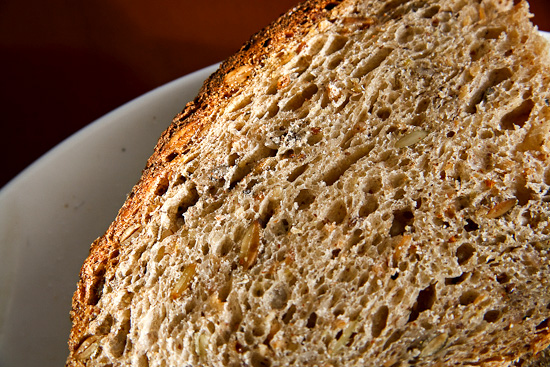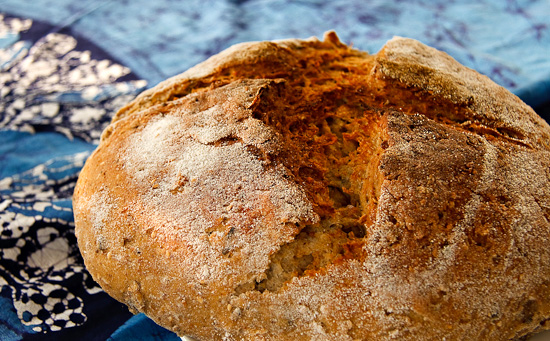I have been baking sourdough bread for more than a year now, and it occurs to me that I’ve learned an awful lot in that time. Not only how to knead dough by hand, or how to shape a loaf using minimal counter space, or how to take care of a starter – but also how to do it all in Beijing, where much of the equipment essential to baking hearth-style rustic loaves are not the most readily available.
But I’ve learned all of that too. How to improvise a banneton, or a couche. Where to find a baking stone, or freshly milled flour. I’ve discovered small Chinese baking shops on Taobao, and found other expats interested in bread baking.
I thought it would be nice to share this information with you, as without help I couldn’t have gotten started, either: specifically Eric A., and his article in the Insider’s Guide to Beijing, 5th edition (2009), p101, which led me to this wonderful shop. I hope you will find this equally helpful and exciting, whether you are baking bread or even just looking for help deciphering all the different varieties of flour available here.
Happy explorations, yeasted and otherwise
Contents
- Intro
- Equipment & Supplies Glossary
- Baking Supplies Stores in Beijing
- Flour Glossary
- Flour Stores in Beijing
- Sourdough in China and other yeasted foods







































Excelelnt resource. Many thanks.
Really, really helpful. Thank you!
Hello there
May I suggest you leave a link to your guide on The Fresh Loaf?
In January the % of visitors to the site from China were 17th = out of the top 100 locations. Perhaps they won’t all have discovered your site ……
http://www.thefreshloaf.com/node/1499/what-country-do-you-live#comment-155189
I ‘found’ your site via Wild Yeast’s Yeast Spotting and have enjoyed following along, and learning about your various experiences. I’m sure other TFLers would be interested in your beautiful site too.
With kind regards, Robyn
Thanks for your suggestion and your kind words, Robyn! I’m a bit shy of self-promotion but it’s a good idea – first, though, I need to get a TFL membership and stop lurking, hehe.
oh. my. god. shelley, you’re my hero. i keep meaning to compile some kind of list, but got to lazy to write it all down. thanks for all the info! and i love the grain shop at dongzhimen – the couple is awesome :)
I am guessing that Robyn is a kiwi and thought you may be interested in a vogels like bread recipe that i have developed this year.
I have long searched for a recipe for a Vogels-like bread and recently adapted Jim Lahey’s no knead white bread to come up with a loaf that is just like vogels, moist and chewy with a great crust. It is baked in a pre heated cast iron dutch oven with a lid, but a pyrex or ceramic container can also be used. No kneading, just mix up ingredients and let time do the kneading for you. Only requires a few minutes hands on time, but requires forward planning as can take from 14 and up to 22 hours before ready to bake depending on the temperature.
Jacquelines slow-rise vogels bread recipe
Place the following dry ingredients in a large bowl and mix well, (seeds and quinoa all optional)
½ cup kibbled wheat
¼ cup kibbled rye
4 cups high grade bread flour
1 cup whole meal flour
¼ cup rolled oats
½ cup sunflower seeds
1/4 cup pumpkin seeds
2 Tbsp Quinoa
2 tbsp flax seed
2 Tbsp chia seeds
2 tbsp sesame seeds
2 tbsp gluten
2 Tbsp skim milk powder
1/3 teaspoon instant yeast
2 3/4 teaspoons salt
Add
3 1/4 cups cold water
1 tsp wine vinegar
Mix well until a shaggy dough forms.
Cover bowl and dough with a plastic bag and leave in a warm place in winter or on bench in summer for 12 -18 hours to rise. Leave for longer if cold weather, it needs to have bubbles forming on the top of the dough when ready
When dough is bubbly on top, stir and fold dough over on itself once or twice, using a silicone spatula. It is a very wet sticky dough.
Cover and let rest about 15 minutes.
1. Using a spatula, gently shape dough into a ball, folding it over on itself, no kneading necessary.
2. Dust flour over the bottom of the bowl and place the dough seam side down into the bowl. Cover and let rise for about 2 hours. When it is ready, dough will be more than double in size and will not readily spring back when poked with a finger.
3. Half an hour before dough is ready, heat oven to 220 deg C and place the 4 1/2 litre cast iron dutch oven and lid in to heat also.
4. Tip dough gently into hot dutch oven container, seam side up. (No need to grease container, doesn’t stick, can use baking paper liner if you must). Sprinkle quickly with water and put lid on pot and place back in oven. (I use a silicone spatula to ease the dough from the sides of the bowl cleanly as I tip it into the bowl. I try to prevent any strands of dough from breaking)
5. Bake 35 minutes then remove lid and bake a further 10-15 minutes to brown top. Remove from oven, tip bread onto a rack, cover with a tea towel and leave to cool. Do not slice until cool..
The quinoa and any of the seeds can be omitted to make a loaf like the “Original Vogels loaf” , costs a lot less but still gives a great textured and chewy bread. I still like to add sunflower seeds if i have them though, they do make it very tasty.
http://www4.snapfish.co.nz/snapfishnz/thumbnailshare/AlbumID=3342918018/a=147198566_147198566/
Thanks Jacqueline, that recipe looks delicious and so healthful too! I’ll have to give it a try sometime, but unfortunately I don’t have anything remotely like a dutch oven.